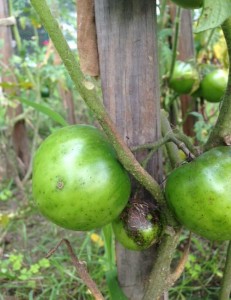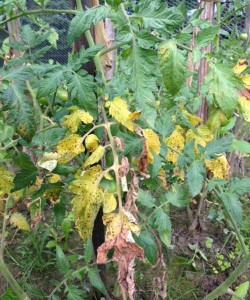By the middle of summer, your plants should be growing well as harvest time draws closer, but that isn’t always the case if the weather has brought too much rain, too much sun or if other factors have influenced your garden’s growing season.
There are countless diseases and problems that can affect your plants at all growing stages. Here are 5 common garden problems and solutions you may be dealing with this summer:
1. Pathogens

Pathogens are viruses that affect plants’ overall health and appearance. If environmental conditions are just right, pathogens can attack plants. Ohio State University Extension explains that if damage develops and spreads over time, the damage is more than likely caused by a pathogen.
University of Missouri Extension lists common diseases that affect garden vegetables. Depending on the disease, cultural controls, chemical controls or both can be effective in combating the disease. Some common plant pathogens are early blight, late blight, powdery mildew and blossom end rot. In many cases, sanitation, which includes removing affected plant debris from the garden to stop the spread of disease, is an effective control method, but certain plants require specific care.
2. Abiotic diseases

Abiotic (non-living) factors can impact plants just as much as biotic (living) factors can. Weather is the main abiotic factor that has the ability to inhibit plant health and destroy crops. OSU Extension says that if plant damage that doesn’t spread is probably caused by an abiotic disease.
Abiotic diseases include physiological factors such as extreme temperature change, wind, hail, excessive rain, drought, chemical burn and exposure to air pollutants like automobile exhaust. Some physical signs that plants are suffering from an abiotic disease are stunted growth and crown dieback.
Michigan State University Extension further explains some common abiotic diseases, including chimeras, galls, burls, low temperature injury, drought, heat and flooding.
3. Insects
The first step to managing insects in the garden is distinguishing beneficial insects and harmful insects. Some harmful insects include slugs, cutworms, Japanese beetles, aphids and white grubs.
Simple practices such as removing plant residue from the previous year’s garden, regularly inspecting plants for insects and insect damage and treating plants with insecticide can remedy insect problems. OSU Extension offers further advice for identifying and managing specific insect pests.
4. Container gardening problems
Although container gardens are advantageous for growers with limited space and pest management can be simpler, problems can still arise.
University of Maine Cooperative Extension lists insufficient sunlight, too much nitrogen, excess water, poor drainage, low temperatures, too little phosphorus and other conditions that can negatively impact plants growing in containers.
Fortunately, the solutions to these problems can be remedied by making changes to plant care, location and pest control. More information can be found in this publication from Texas AgriLife Extension Service.
5. Flower garden problems
Pathogens, abiotic factors and insects affect flowers just like they do garden plants. Some problems affect the entire plant, while others affect just the leaves or only the flowers.
The University of Tennessee Agricultural Extension Service lists common garden flower problems ranging from plants that fail to flower and discolored leaves to fungi and insect infestations. For each problem, potential causes and controls are suggested to bring your flowers back to health.
PSU Extension offers information about many perennial flower diseases here.
Ask an expert
Penn State University Extension offers this guide for narrowing down the identification process when diagnosing your plants. Ohio State University Extension suggests 20 questions that plant growers should ask when attempting to diagnose a plant problem, including common problems with the plant, the plant’s overall health and what other plants look like.
If you’re not sure about the problems that your plants are experiencing, call an expert. Your local extension office will be able to point you in the right direction.
2 more posts about managing garden problems:
- How to manage your garden after too much rain June 23, 2015
- How to manage insects in the garden May 12, 2015
STAY INFORMED. SIGN UP!
Up-to-date agriculture news in your inbox!











